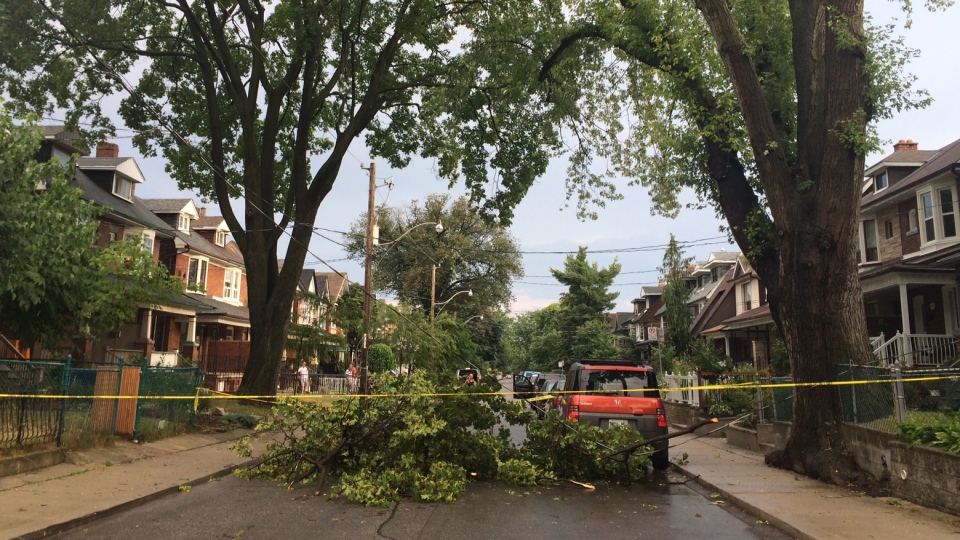High Winds Can Damage Electrical Systems!
Electrical Safety Authority recommends checking your home for possible damage to electrical systems and equipment caused by the storm.
With the significant storm damage that occurred over the summer, the Electrical Safety Authority (ESA) is cautioning all Ontarians affected by storms to check around and in their home for potential electrical damage and to take safety precautions. Residents are advised that if there is serious damage to a home’s connection to the electricity system, the utility may not be able to safely restore power. There could also be damage to the equipment even if the power was not lost during the storm. Follow these electrical safety tips; it could save your life, or the lives of first responders and utility personnel working in the area:

Cleaning up after the storm
When attempting to clean up after the storm please follow these tips:
- Downed powerlines may be live and are extremely dangerous. Stay back at least 10 metres (33 feet). Electricity can travel through water and the ground around powerlines.
- Call 911 and the local electricity distribution company to report any downed lines. Remain well back.
- Please wait until the power is disconnected or powerlines are repaired before starting yard cleanup – downed powerlines may be hidden beneath debris and tree branches.
Look for possible damage to electrical service coming into your home –
Visually check (do not touch!) for damage to electrical wires connecting your home to hydro wires on the street. If these wires are down, sagging, touching trees or your home, or pulled away from your home or the hydro wires:
- Do not touch! Even if you believe the power is off.
- Stay back at least 10 meters (33 feet) (about the length of a school bus) back from the wires.
- Do NOT attempt to repair yourself.
- Contact a Licensed Electrical Contractor to make repairs.
Look for damage to the overhead electrical connection to your house (service mast) –
Visually check (do not touch!) for damage to your service mast. These are the pipes typically attached to the side of a house, connecting incoming hydro wires to the electrical meter. If the mast is bent, pulled away from your home or otherwise damaged in any way, contact a Licensed Electrical Contractor to arrange repairs.
- Do not touch! Even if you believe the power is off.
- Stay back at least 10 meters (33 feet) (about the length of a school bus) back from the wires.
- Do NOT attempt to repair yourself.
- Contact a Licensed Electrical Contractor to make repairs.
Flooded basement? Don’t go down there!
If water has risen above the level of power outlets or near the main electrical panel, do not go into the basement. Electricity can travel through water or wet flooring and you could receive a shock. Contact your electric utility to disconnect power immediately and then contact a Licensed Electrical Contractor to make repairs.
ESA reminds all homeowners and businesses including restoration companies to ensure that power has been disconnected to the entire property before entering to avoid shock and electrocution. This includes flooded basements and outbuildings that contain electrical equipment or are connected to the electrical system.
Four steps to ensure electrical repairs are done properly
ESA strongly recommends you hire a Licensed Electrical Contractor to evaluate your home’s electrical system to determine if it is safe.
- The contractor will arrange for an electrical permit with the ESA so there is a record of the work;
- When the contractor completes the work, the contractor will notify ESA and the ESA Inspector will confirm work has been done safely and that it meets the Ontario Electrical Safety Code so that power can be reconnected;
- ESA will inform the utility that it is safe to reconnect; the utility will reconnect when it is able to do so.
- After the work is done, ask the contractor for a copy of the ESA Certificate of Inspection for your records and insurance.
Preparing for Future Storms
Here are a few tips that Ontarians can take to help them prepare for the next summer storm.
- Make sure you have an emergency survival kit ready. Ontario’s Emergency Management Office recommends every family have an emergency survival kit containing items that you’ll need to remain comfortable for at least three days immediately after or during an emergency.
- View this video from Toronto Hydro: Essential Items for a Household Emergency Kit.
- Check the trees on your property and call your local electric utility to trim branches away from overhead powerlines before a storm. High winds can bring trees and branches down onto powerlines causing power outages and electrically charged hazards.
About the Electrical Safety Authority (ESA)
The Electrical Safety Authority (ESA) is an administrative authority acting on behalf of the Government of Ontario with specific responsibilities under the Electricity Act and the Safety and Consumer Statutes Administration Act. As part of its mandate, ESA is responsible for administering regulation in four key areas: the Ontario Electrical Safety Code; licensing of Electrical Contractors and Master Electricians; electrical distribution safety; and electrical product safety.
For further information:
Electrical Safety Authority Media Relations
905-712-7819 or Media.ESA@electricalsafety.on.ca
